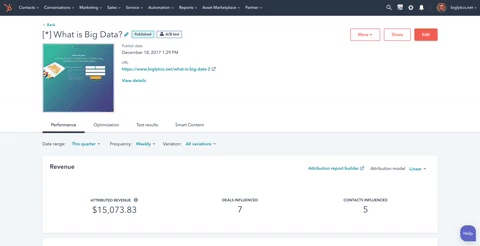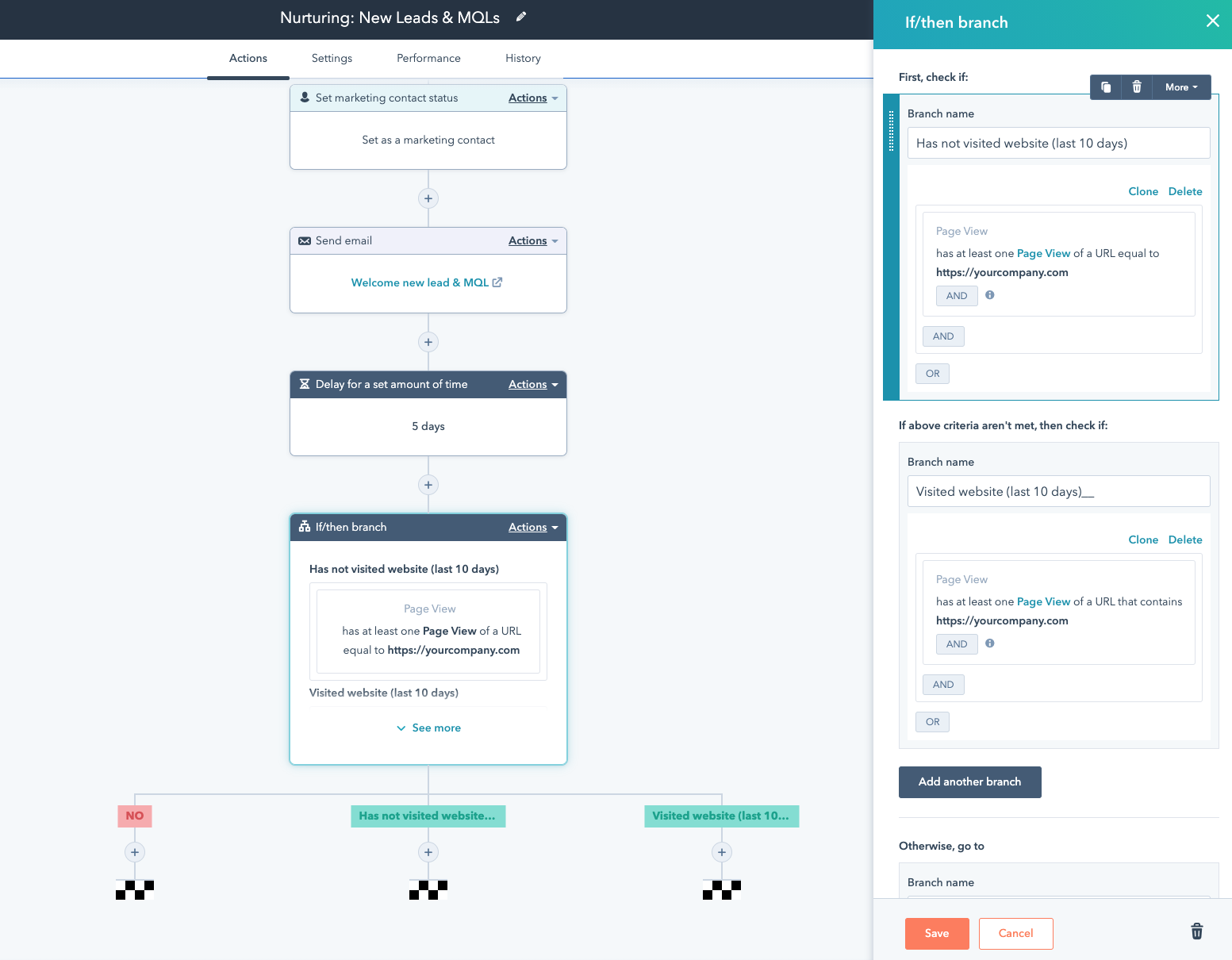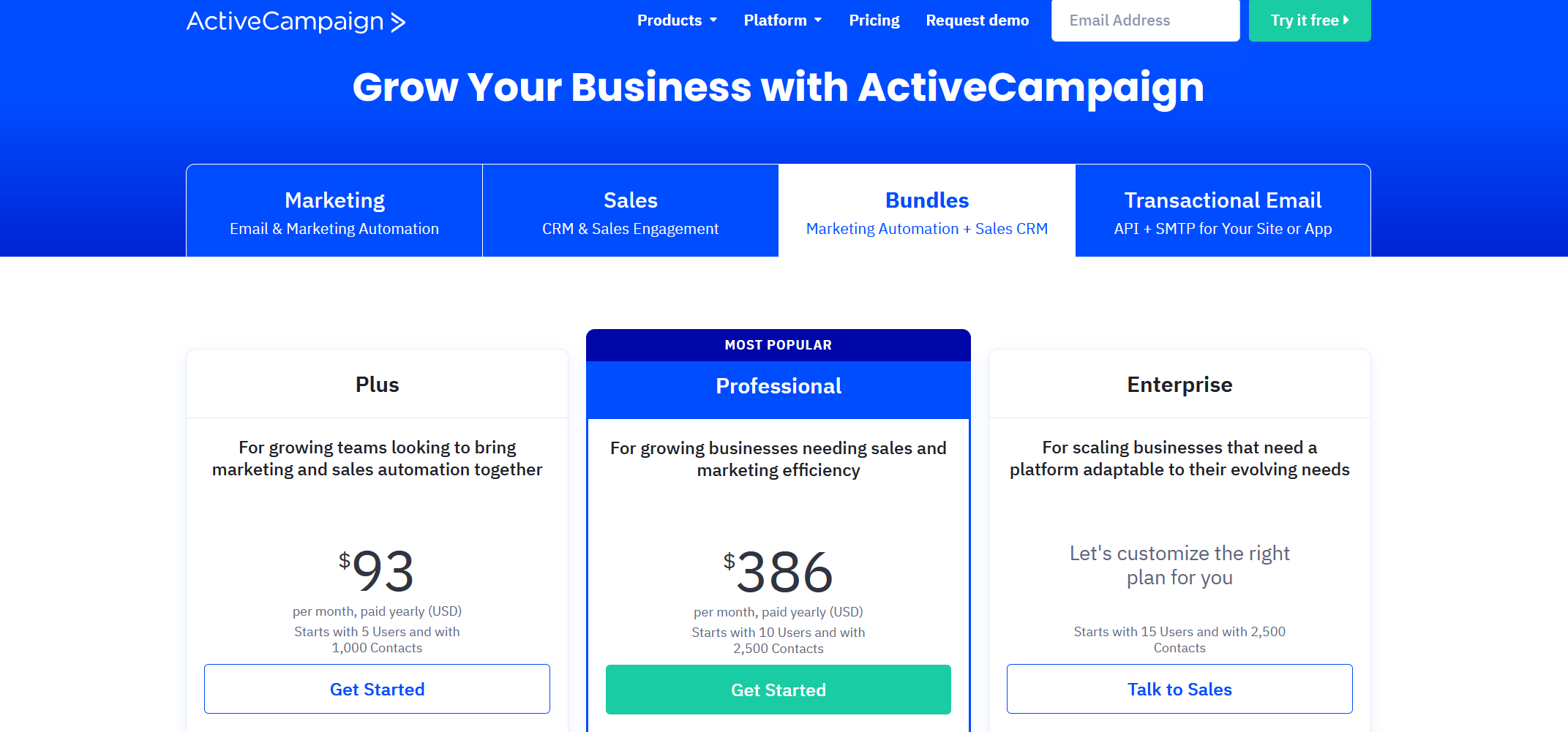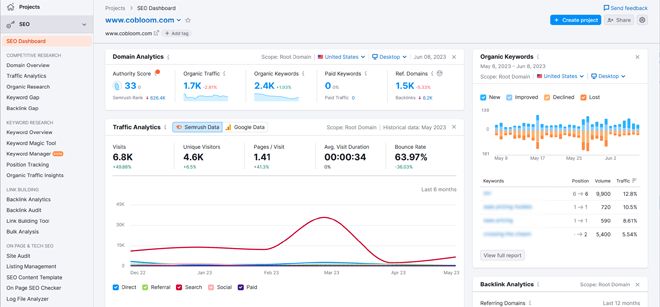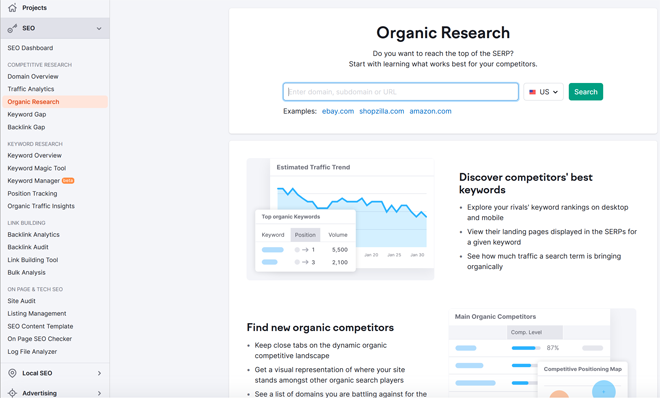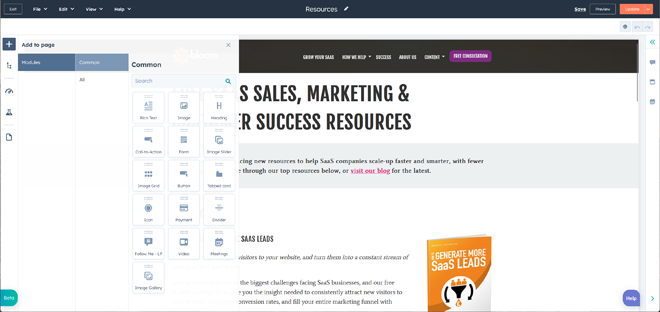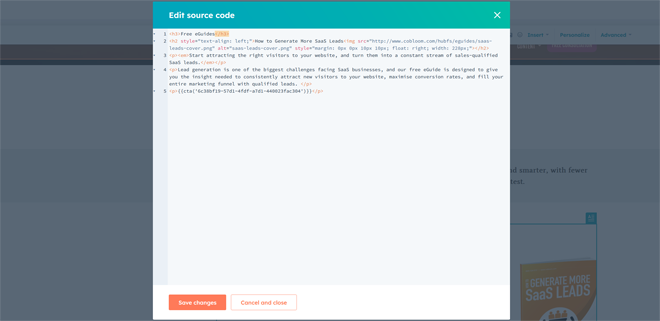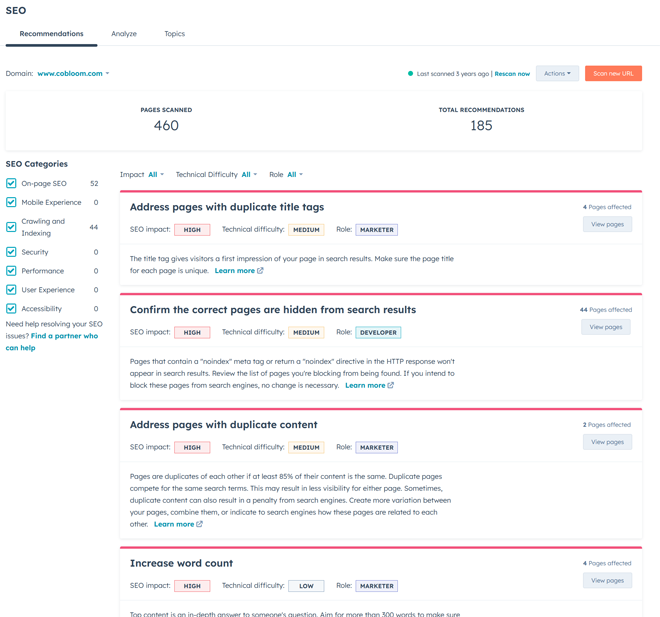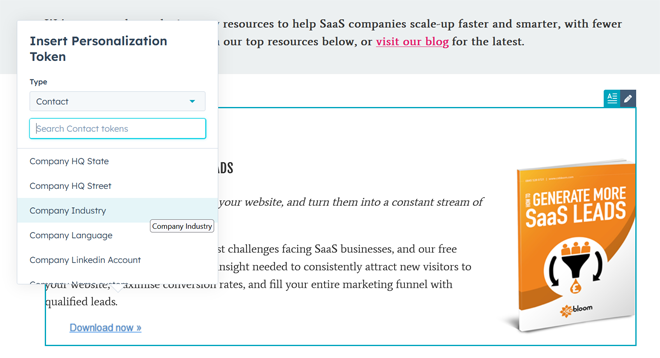Inbound marketing is impossible without the right software.
It doesn’t matter whether you’re implementing a full-funnel inbound marketing strategy, or just trying to drive more targeted traffic to your SaaS company website. You need a toolkit to be effective.
For the last decade I’ve implemented and extensively used inbound marketing software for both Cobloom, and the companies we work with.
Our top recommendations power this website, and its marketing.
In today’s post I explore why SaaS companies need inbound marketing software, and review the most popular tools available, so you can make informed choices.
Let’s get started!
Last updated in June 2023.
An Introduction to Inbound Marketing Software for SaaS
What is Inbound Marketing?
Marketing strategies can broadly be split into two distinct categories: inbound marketing, and outbound marketing. Inbound marketing is all about attracting people to your website and brand, whereas outbound marketing is focused on pushing your messages out to potential customers.
Core Inbound Marketing Tactics
- Blogging – regularly writing search optimised blog content, driving traffic to your website from search engines
- Landing Page Creation & Optimisation – creating landing pages with forms on them, which convert website visitors into leads
- Email Marketing – sending emails to leads generated with your inbound marketing strategy, to convert them into free trials / demos / sales
- Marketing Automation & Lead Nurturing – automating marketing processes with software, such as the sending of sequences of emails designed to “nurture” a lead so that they’re ready for a free trial / demo / sales conversation
- Search Engine Optimisation – optimising your website for search engines & using link building strategies to maximise search rankings
- Lead Generation Content Creation – creating helpful content like eGuides and whitepapers, usually promoted on landing pages to generate leads
- Webinar & Video Marketing – creating high quality video content to help educate website visitors & leads
- Surveys / Quizzes – using surveys/quizzes to turn website visitors into leads and collect useful statistics for creating your own reports, etc
- Social Media Marketing – building a brand and audience on social media, driving regular traffic back to your website
- Pay Per Click Marketing (PPC) – Paying per click for traffic from search engines or social media websites. For the purposes of this post, we include pay per click marketing as an inbound marketing strategy, but it’s borderline.
We include it because the most effective inbound strategies typically also leverage PPC either to start a campaign, or boost it, and PPC functionality is included in the software we’ve reviewed.
There are many others, but most SaaS companies with effective inbound marketing strategies will be using the above tactics as the main building blocks of their campaigns.
What Types of Inbound Marketing Software Are Available?
In this resource I focus on Inbound Marketing Platforms, SEO Tools & Content Management Systems (CMS).
- Inbound Marketing Platforms – software in this category provides a suite of tools designed to allow you to efficiently implement the core tactics outlined above (and more). Top performing SaaS companies select one of these, then use other tools where necessary to fill gaps or supplement requirements.
- SEO Tools – search engines are central to inbound marketing, and the best performing SaaS companies use advanced SEO tools to ensure their website is optimised appropriately and continually attracting more search traffic.
- Content Management Systems (CMS) – a content management system is what you use as a platform for your marketing website. It’s where your website design and all your content goes. Every SaaS company should be using a content management system of some form, or managing your marketing website becomes impossible.
There are other categories of inbound marketing software out there, but they’re increasingly specialist, and aren’t of much use until you have the above essential tooling in place.
Quick fact: did you know that digital marketing software spend reached $66.7 billion in 2022? Total spend is expected to reach at least $161.7 billion by 2028, a growth rate of 15.8% per year. Source: IMARC Group
Inbound Marketing Platforms for SaaS Companies
1) HubSpot
HubSpot’s Marketing Hub® provides you with all of your inbound marketing tools and data — connected in one place. You can start using their CRM, email marketing, forms, landing pages, live chat, blog, pay per click ad management and contact management features for free.
Premium versions go much further, including omni-channel marketing automation, retargeting, SEO, blogging, social media management, account-based marketing, testing, predictive lead scoring, API/Webhook integrations and advanced analytics covering the entire customer journey.
HubSpot Enterprise offers single sign-on, custom objects, team management tools, multi-touch revenue attribution, custom events, HubDB, and much more, to really meet the needs of Scale-ups that have multiple marketing team members and the most complex requirements.
The Marketing Hub® is designed to help you reach the right people at the moments when they’re ready to take the next step in the purchasing journey:
And this really is just scratching the surface.
We’ve used HubSpot for ourselves and our clients since 2013, and have been delighted with the software & support we’ve received throughout that journey. The platform achieves a difficult balance exceptionally well: providing power & customisability to those who need it, while remaining very easy-to-use.
HubSpot is without doubt the best Inbound Marketing Platform for SaaS companies of all sizes: the free tools are great for very early stage start-ups, while HubSpot Marketing Pro & Hubspot Marketing Enterprise serve scale-ups better than any other platform.
G2 Crowd features HubSpot in the top-right of its Marketing Automation Software grid, as having the overall combined greatest market presence & customer satisfaction ratings, well ahead of other leading platforms:
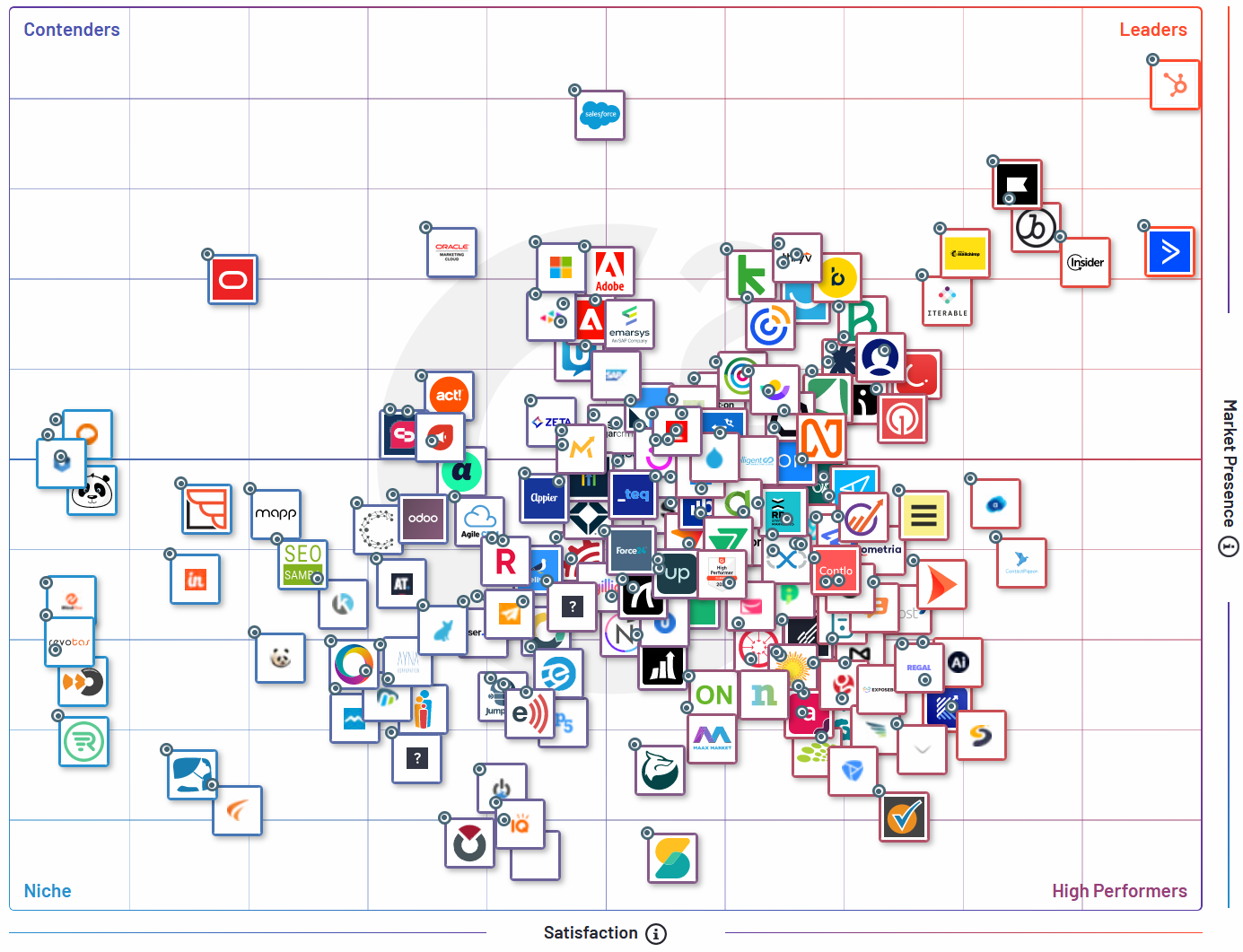
In addition to this, HubSpot is ranked as the #1 Overall Best Product for Marketers by G2 Crowd: remember, HubSpot is a comprehensive Inbound Marketing Platform, not just Marketing Automation software.
If you’re a Start-up SaaS company (you have an early stage product, but perhaps aren’t sure if you have product/market fit and aren’t in “scaling mode”), click here to learn more about the Marketing Hub®, and get started for free.
If you’re a Scale-up SaaS company (you already have an established product, and are focused on scaling up growth), learn more about HubSpot Marketing Pro by starting a free 14-day trial of their advanced platform.
Quick fact: did you know that HubSpot’s co-founder Brian Halligan coined the term “inbound marketing”, back in 2005?
2) ActiveCampaign
ActiveCampaign is a Customer Experience Automation platform that helps SaaS companies to engage with potential (and existing) customers. Its Plus package includes email marketing, forms, landing pages, marketing automation, API/Webhook integrations and more.
The Professional package goes further, offering AI-powered predictive sending functionality, split automations, site messages and attribution reporting. There’s also an Enterprise package which includes things like single sign-on, custom objects, SLAs and important features established SaaS companies might need.
ActiveCampaign is the closest thing you’ll find to a direct competitor of HubSpot’s comprehensive Inbound Marketing Platform.
Unlike HubSpot, its platform doesn’t include a free CRM by default, but you can purchase a bundle of ActiveCampaign’s Marketing Automation + CRM which starts at just $93 per month. In contrast to some of the platforms featured later in this article, ActiveCampaign’s CRM is natively integrated with its Marketing Automation Software to offer a seamless user experience.
You’ll note from the feature list that as of the writing of this post, ActiveCampaign doesn’t have a blog, Content Management System, or SEO tools. This means that if you choose to use ActiveCampaign you’ll need to have your marketing website hosted on an external CMS, which adds some technical complexity.
While narrower in scope, ActiveCampaign is an appealing solution to SaaS companies where cost is the central concern (so especially early-stage, bootstrapped Startups and SaaS teams with only 1 or 2 marketing employees), and HubSpot’s free tools just don’t provide the depth of functionality you need.
Both ActiveCampaign and HubSpot have high rates of Highly Satisfied customers: in 2022 a survey was commissioned (by HubSpot) of both company’s paying customers. 958 HubSpot customers were surveyed, and 498 ActiveCampaign customers. According to the survey, 37% of HubSpot customers were “Highly Satisfied” (scoring 9-10 out of 10 on the customer satisfaction survey), in comparison to 33% of ActiveCampaign customers.
If you’ve ever done customer satisfaction surveys before, you’ll know that both these scores are very good, demonstrating the quality of both companies’ products & service levels.
The results of that survey align with the G2 Crowd Marketing Automation grid too (for anyone shouting about bias!), where you can see that ActiveCampaign is the only other Marketing Automation software provider with similar customer satisfaction ratings to HubSpot (the ActiveCampaign logo is the blue logo in the top-right, directly below HubSpot’s orange logo):
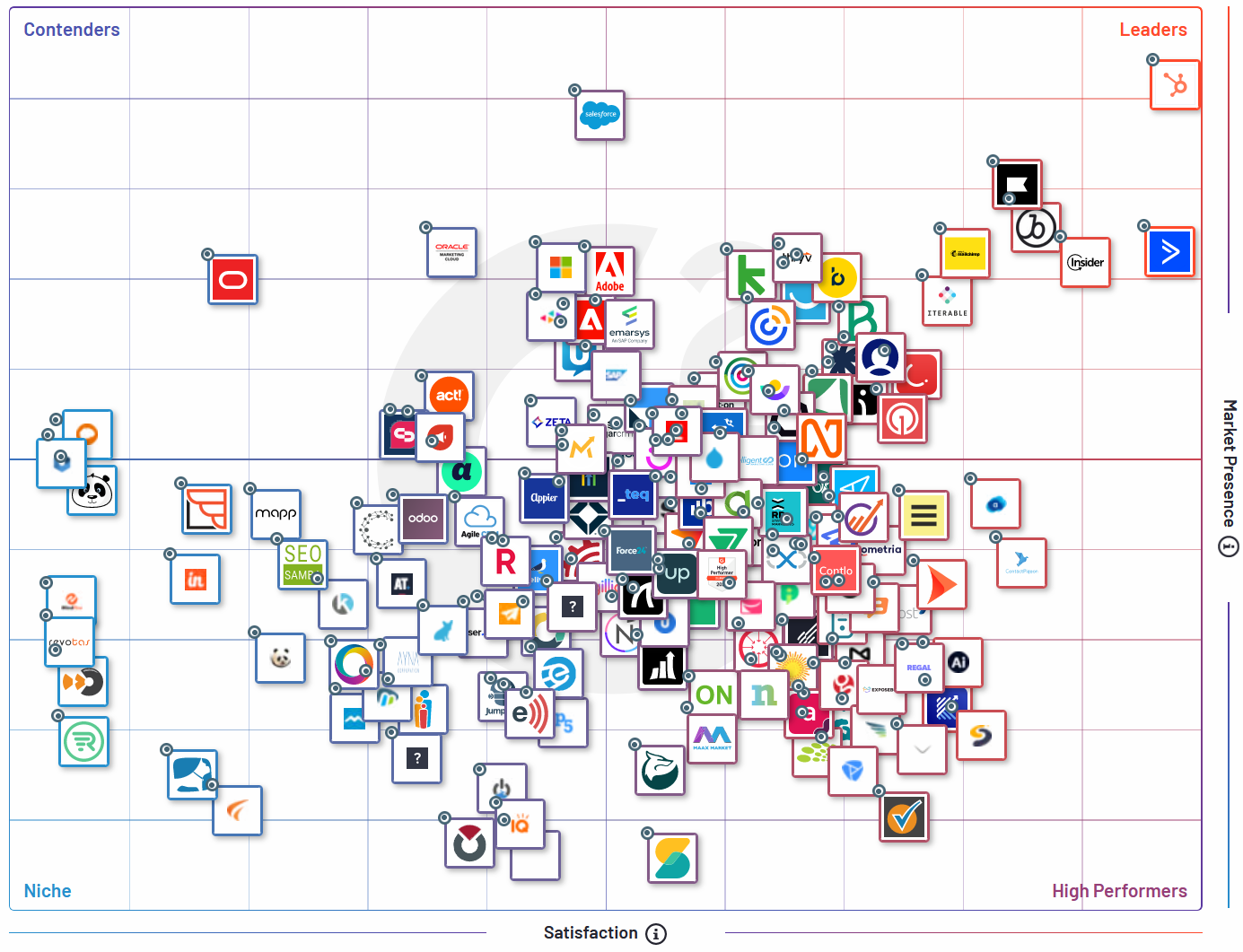
To summarise, and help you answer whether you should choose HubSpot or ActiveCampaign as your central Platform:
- Choose HubSpot if you want a comprehensive all-in-one solution which will scale with your SaaS. HubSpot is usually the best solution for funded start-ups, scale-ups and more established SaaS companies.
- Choose ActiveCampaign if you’re happy to integrate more tools together to deliver and report on your Inbound Marketing Campaigns, and your main software requirement is Email Marketing and Marketing Automation. ActiveCampaign serves as a great “second-best” when budgets are stretched, and works well for bootstrapped start-ups.
3) Adobe Marketo Engage
Marketo is a tool which primarily offers email marketing, marketing automation, landing pages, forms, A/B testing, account-based marketing, reporting and SEO. They also provide a chatbot which can be used to engage visitors while they’re using your website. They do not have a free version of their product currently.
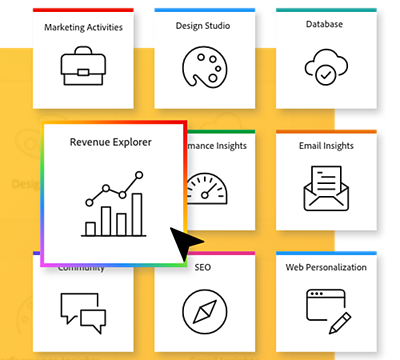
A major reason we don’t rank Marketo as highly as HubSpot or ActiveCampaign is that their product offering is much narrower, which means that you need to combine it with other tools to do everything they do. It doesn’t really enable you to implement effective inbound marketing strategies from the start, “out of the box”, like HubSpot, and is much more expensive than ActiveCampaign.
Marketo also doesn’t include a CRM, which means you’ll need to use and integrate another CRM if you don’t already have one in order to use it properly.
Note: HubSpot and ActiveCampaign also support integrations with external CRM systems, if you don’t want to migrate from what you’re currently using.
For SaaS companies serious about growth, we don’t think there’s any real comparison to HubSpot that can be made as an overall Inbound Marketing Platform. Marketo simply hasn’t been designed for the purpose from the ground up like HubSpot was.
Still, Marketo remains a popular alternative Marketing Automation platform, ranked #8 by G2 Crowd and #3 by Gartner, and is one of HubSpot’s closer competitors when it comes to an Inbound Marketing Platform’s required feature set.
As a platform we don’t think it’s really suitable for start-ups, but scale-ups can request their free Interactive Tour.
4) Pardot (Salesforce Marketing Cloud Account Engagement)
Pardot is a tool which primarily offers email marketing, marketing automation, lead nurturing, landing pages, forms, A/B testing & reporting. It was acquired in 2007 to help Salesforce build out their portfolio of products, and enter the marketing automation space.
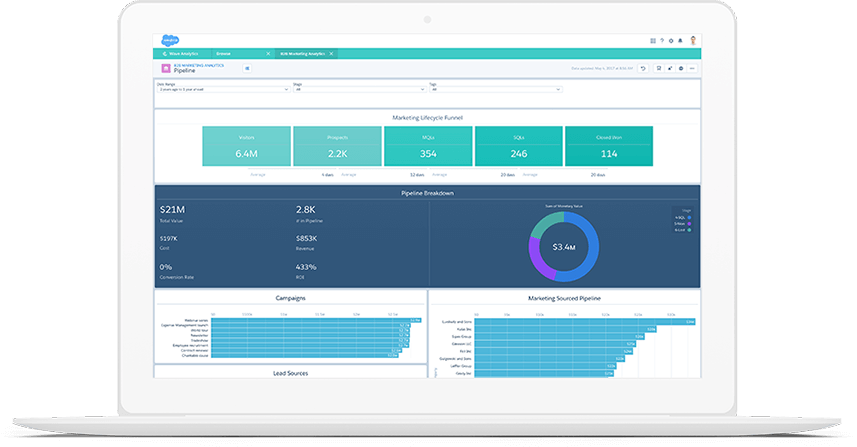
It’s one of the most popular marketing automation platforms because its owned by Salesforce, who promote it to their existing base of CRM customers. You’ll notice on the G2 Crowd Marketing Automation Grid that they have a similar Market Presence to HubSpot (top center):
Unfortunately you’ll also note that Pardot’s Customer Satisfaction rating is about half that of HubSpot and ActiveCampaign’s, in the middle of the pack (similar to Adobe Marketo, which is a bit lower in terms of Market Presence).
Generally speaking, Pardot tends to be more difficult to use than HubSpot and ActiveCampaign. Salesforce have grown their product offering primarily by acquiring other companies, and that means all their software requires integrations which can get quite complex.
Another flaw is that due to how Pardot’s landing page integration works, you often have to host landing pages on a subdomain or third party website separate from your main marketing website, which adds complexity to the user experience/reporting, and negatively impacts SEO.
Like Marketo, you’ll need to integrate with a separate CRM, as a CRM isn’t included with Pardot. Salesforce (naturally) recommend Salesforce, but last time we checked the integration is still manual rather than native.
Regardless of those downsides, Pardot is one of the more popular Marketing Automation platforms, and still used by a number of SaaS companies in spite of those flaws. At the price point we’re unsure why an informed buyer would choose Pardot over HubSpot if they wanted to do inbound marketing, however.
You can request a free demo of Pardot via the button below. It’s only really suitable for scale-ups happy to manually integrate with lots of other software, and starts from $1,250 per month.
SEO Tools for SaaS Companies
1) SEMRush
Semrush is what we’d describe as the ultimate SEO tool. It’s an all-in-one tool suite you can use to increase your online visibility and discover actionable marketing insights.
In our experience, it’s not enough to “just” have an Inbound Marketing Platform for your SEO: you also need a tool to help with research, so you know what keywords you should be targeting, how your search engine rankings are evolving and how to improve upon your linkbuilding strategy. Semrush is the software you want for this.
Within Semrush there are tools which help you with: keyword research, on-site SEO, competitor SEO analysis, local SEO, content strategy, search rank tracking, link building, content performance analytics, and more.
We recommend it as a must-have tool for SaaS companies which are serious about SEO. There are three tiers of packages, but we find that most SaaS companies have what they need within the cheapest Pro Package ($119.95/mo for 1 user).
There are loads more useful add-ons, but the need for these is much more case-by-case, and you can learn about this premium functionality on the Semrush website.
2) Ahrefs
Ahrefs is a close second to Semrush. It started out as a tool primarily for analysing links (hence the name!) but has evolved over the years to compete directly with Semrush’s research tools.
While Ahrefs in some cases has a slightly better designed user interface, Semrush provides you with a lot more data across both SEO & PPC, making it a better choice for keyword research purposes.
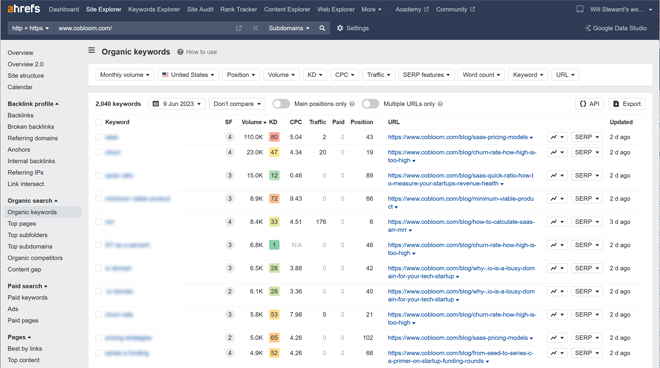
When it comes to linkbuilding & backlink analysis, some quick testing by us suggested that both Semrush and Ahrefs detect a similar number of backlinks, meaning that overall there isn’t that much in it.
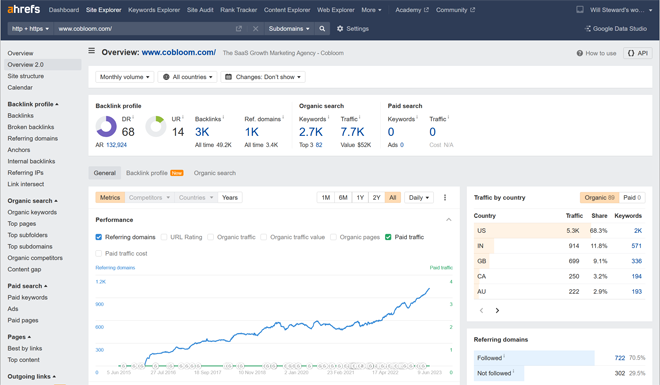
For established websites, other third party research has found that Semrush tends to find a few more links than Ahrefs, typically in the order of ~1% more referring domains.
Finally, when it comes to comparing Ahrefs technical SEO site audit functionality with Semrush, I’d argue that Ahrefs falls a bit behind again. Ahrefs has a tendency to flag up issues which aren’t really issues (e.g. setting some pages as noindex, something there are many good reasons for doing!)
Semrush by comparison provides you with loads of great, actionable site audit advice you can use that supplements HubSpot’s site optimisation recommendations exceptionally well, while filtering out the noise.
In terms of cost, Ahrefs starts at $99/mo, but many SaaS companies may find they need the Standard ($199/mo) or Advanced ($399/mo) packages to get the functionality they need.
Content Management Software for SaaS Companies
1) HubSpot
HubSpot’s CMS Hub® makes building scalable SaaS marketing websites easy. You can use it to create and personalise website pages for every visitor – optimised to convert across all devices. Flexibility within the CMS and intuitive drag & drop page builders mean you can rely on developers as much or as little as you’d like.
This website (cobloom.com) & blog is built entirely on the HubSpot CMS Hub®. Sometimes when I’m editing content I use the drag & drop tools, others I edit source code directly. I’ve had colleagues who know nothing about website development edit page templates, designs and content without issue using only drag & drop.
Like HubSpot’s other products, you can even start using the website pages, blog, drag-and-drop editor, basic SEO tools, managed cloud hosting & website traffic analytics for free.
Premium versions of the CMS enable you to deploy as many websites/pages/blogs as you want, receive automated advanced SEO recommendations, create dynamic content, build contact attribution reports, perform A/B testing and do adaptive testing.
Digging a bit further into the dynamic content functionality, you can effectively personalise website content the same way you can personalise emails with HubSpot’s email marketing software. Check out the screenshot below, where I’m adding a contact’s “Company Industry” to a webpage:
Like with email, you can set a “default” that people who aren’t contacts in your database see when they visit the page too. So for a “Company Industry” example a default might be “your industry”, where a known contact would instead see “manufacturing industry”, or “software industry”. This personalisation helps to boost engagement and conversions.
I could go on and on, but you really need to see the software to fully appreciate it.
It’s the only CMS for SaaS companies that’s both powerful and easy-to-use.
2) WordPress
It’s impossible to talk about CMS’ without also reviewing the world’s most popular free CMS: WordPress.
Before re-branding as Cobloom in 2016, our company was known as Iconsive, and we initially hosted the company’s marketing website on WordPress. I’ve heavily used WordPress myself, and spent many years building and optimising WordPress websites.
The biggest thing to highlight is that WordPress isn’t a CMS optimised for inbound marketing: it’s a generic CMS designed to be customised with themes & plugins. In order to effectively implement inbound marketing strategies with WordPress your marketing team will need to regularly have someone available who knows how to code, and use plugins for SEO functionality, analytics, forms, etc.
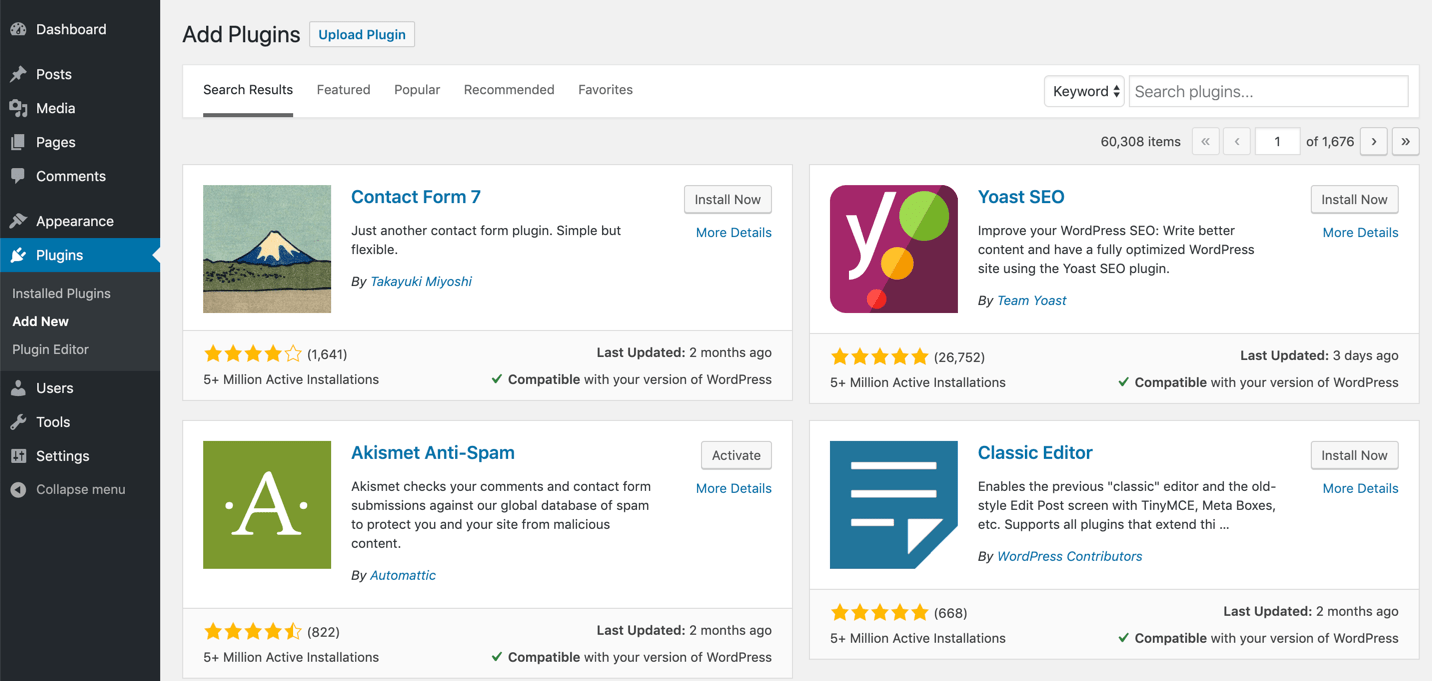
It’s worth noting here that if you were to install 24 of the most popular WordPress plugins, you’d be paying between $287 and $1,338 per month for them. Many of the best plugins aren’t free.
Also, unlike HubSpot, WordPress is a software package that has to be installed & configured on either your servers, or the servers of a third-party hosting provider. This means that WordPress isn’t totally free even without plugins. Hosting costs can add up, especially if your website drives significant amounts of traffic or you plan to do lots of webinars/video marketing. HubSpot by comparison takes care of all of that for you, so you don’t have to worry.
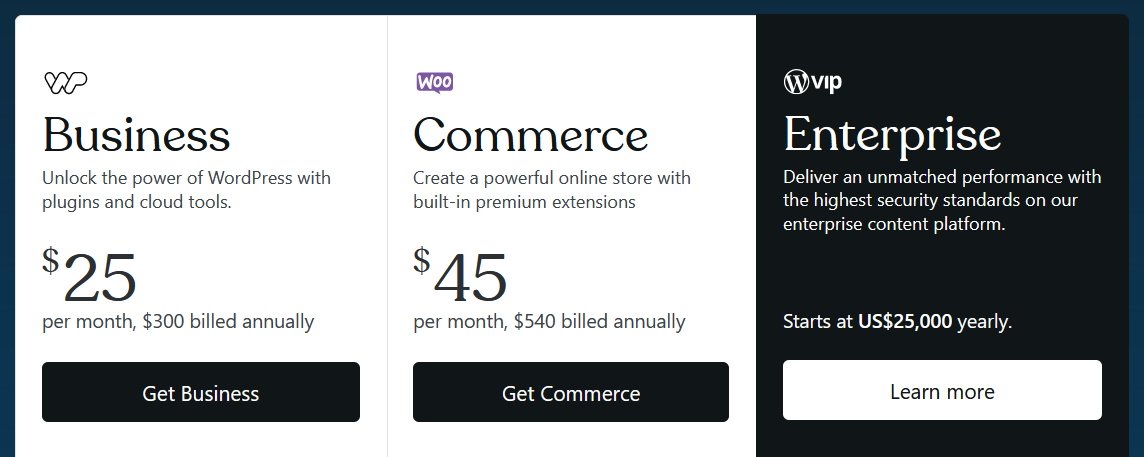
WordPress none-the-less remains a popular CMS, and many SaaS marketing websites continue to use it in spite of the associated complexity. You can learn more about WordPress on their website, here.
If you don’t want to host your own WordPress instance, you can get managed WordPress hosting here.
It’s worth noting that if you have a strong reason for wanting to use WordPress over the HubSpot CMS Hub®, that HubSpot has its own WordPress plugin and integrates exceptionally well. Many SaaS companies achieve results hosting their website on WordPress, while using HubSpot’s Marketing Hub as their Inbound Marketing Platform.
Conclusion
To conclude, if you were to ask me the question, “what inbound marketing software combination will maximise the performance of our SaaS marketing strategy?” I’d answer as follows:
- Use HubSpot’s Marketing Hub® as your Inbound Marketing Platform. It’s functionality is second-to-none, and you won’t regret using it at the centre of your marketing. We’ve recommended HubSpot to many SaaS companies who have successfully used HubSpot Pro & HubSpot Enterprise for years without looking back.
If you’re a bootstrapped start-up, HubSpot is too expensive, and you want more than their free tools offer, use ActiveCampaign.
- Use Semrush‘s tools to really take your SEO to the next level. If you’re serious about achieving inbound marketing success, SEO is essential. While HubSpot contains a number of great SEO tools (in particular for on-site optimisation); you also need something more for market research, keyword research, competitor analysis and linkbuilding analysis. That’s where Semrush comes in.
Semrush is essential if you’re using ActiveCampaign, as the platform does not offer built-in on-site SEO optimisation features.
- Use HubSpot’s CMS Hub® as your content management system. If you’re using HubSpot for your marketing, it makes a lot of sense to use their CMS too. The integration is seamless, and it’s packed full of functionality which in our experience makes it a much better option than generic CMS software like WordPress.
- SEO Powered Content & PR Distribution. Get Amplified Today.
- EVM Finance. Unified Interface for Decentralized Finance. Access Here.
- Quantum Media Group. IR/PR Amplified. Access Here.
- PlatoAiStream. Web3 Data Intelligence. Knowledge Amplified. Access Here.
- Source: https://www.cobloom.com/blog/best-inbound-marketing-software-saas


